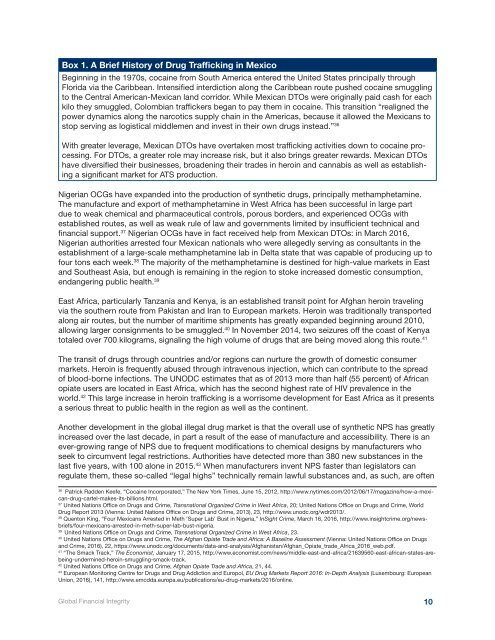Transnational Crime and the Developing World
Transnational_Crime-final
Transnational_Crime-final
You also want an ePaper? Increase the reach of your titles
YUMPU automatically turns print PDFs into web optimized ePapers that Google loves.
Box 1. A Brief History of Drug Trafficking in Mexico<br />
Beginning in <strong>the</strong> 1970s, cocaine from South America entered <strong>the</strong> United States principally through<br />
Florida via <strong>the</strong> Caribbean. Intensified interdiction along <strong>the</strong> Caribbean route pushed cocaine smuggling<br />
to <strong>the</strong> Central American-Mexican l<strong>and</strong> corridor. While Mexican DTOs were originally paid cash for each<br />
kilo <strong>the</strong>y smuggled, Colombian traffickers began to pay <strong>the</strong>m in cocaine. This transition “realigned <strong>the</strong><br />
power dynamics along <strong>the</strong> narcotics supply chain in <strong>the</strong> Americas, because it allowed <strong>the</strong> Mexicans to<br />
stop serving as logistical middlemen <strong>and</strong> invest in <strong>the</strong>ir own drugs instead.” 36<br />
With greater leverage, Mexican DTOs have overtaken most trafficking activities down to cocaine processing.<br />
For DTOs, a greater role may increase risk, but it also brings greater rewards. Mexican DTOs<br />
have diversified <strong>the</strong>ir businesses, broadening <strong>the</strong>ir trades in heroin <strong>and</strong> cannabis as well as establishing<br />
a significant market for ATS production.<br />
Nigerian OCGs have exp<strong>and</strong>ed into <strong>the</strong> production of syn<strong>the</strong>tic drugs, principally methamphetamine.<br />
The manufacture <strong>and</strong> export of methamphetamine in West Africa has been successful in large part<br />
due to weak chemical <strong>and</strong> pharmaceutical controls, porous borders, <strong>and</strong> experienced OCGs with<br />
established routes, as well as weak rule of law <strong>and</strong> governments limited by insufficient technical <strong>and</strong><br />
financial support. 37 Nigerian OCGs have in fact received help from Mexican DTOs: in March 2016,<br />
Nigerian authorities arrested four Mexican nationals who were allegedly serving as consultants in <strong>the</strong><br />
establishment of a large-scale methamphetamine lab in Delta state that was capable of producing up to<br />
four tons each week. 38 The majority of <strong>the</strong> methamphetamine is destined for high-value markets in East<br />
<strong>and</strong> Sou<strong>the</strong>ast Asia, but enough is remaining in <strong>the</strong> region to stoke increased domestic consumption,<br />
endangering public health. 39<br />
East Africa, particularly Tanzania <strong>and</strong> Kenya, is an established transit point for Afghan heroin traveling<br />
via <strong>the</strong> sou<strong>the</strong>rn route from Pakistan <strong>and</strong> Iran to European markets. Heroin was traditionally transported<br />
along air routes, but <strong>the</strong> number of maritime shipments has greatly exp<strong>and</strong>ed beginning around 2010,<br />
allowing larger consignments to be smuggled. 40 In November 2014, two seizures off <strong>the</strong> coast of Kenya<br />
totaled over 700 kilograms, signaling <strong>the</strong> high volume of drugs that are being moved along this route. 41<br />
The transit of drugs through countries <strong>and</strong>/or regions can nurture <strong>the</strong> growth of domestic consumer<br />
markets. Heroin is frequently abused through intravenous injection, which can contribute to <strong>the</strong> spread<br />
of blood-borne infections. The UNODC estimates that as of 2013 more than half (55 percent) of African<br />
opiate users are located in East Africa, which has <strong>the</strong> second highest rate of HIV prevalence in <strong>the</strong><br />
world. 42 This large increase in heroin trafficking is a worrisome development for East Africa as it presents<br />
a serious threat to public health in <strong>the</strong> region as well as <strong>the</strong> continent.<br />
Ano<strong>the</strong>r development in <strong>the</strong> global illegal drug market is that <strong>the</strong> overall use of syn<strong>the</strong>tic NPS has greatly<br />
increased over <strong>the</strong> last decade, in part a result of <strong>the</strong> ease of manufacture <strong>and</strong> accessibility. There is an<br />
ever-growing range of NPS due to frequent modifications to chemical designs by manufacturers who<br />
seek to circumvent legal restrictions. Authorities have detected more than 380 new substances in <strong>the</strong><br />
last five years, with 100 alone in 2015. 43 When manufacturers invent NPS faster than legislators can<br />
regulate <strong>the</strong>m, <strong>the</strong>se so-called “legal highs” technically remain lawful substances <strong>and</strong>, as such, are often<br />
36<br />
Patrick Radden Keefe, “Cocaine Incorporated,” The New York Times, June 15, 2012, http://www.nytimes.com/2012/06/17/magazine/how-a-mexican-drug-cartel-makes-its-billions.html.<br />
37<br />
United Nations Office on Drugs <strong>and</strong> <strong>Crime</strong>, <strong>Transnational</strong> Organized <strong>Crime</strong> in West Africa, 20; United Nations Office on Drugs <strong>and</strong> <strong>Crime</strong>, <strong>World</strong><br />
Drug Report 2013 (Vienna: United Nations Office on Drugs <strong>and</strong> <strong>Crime</strong>, 2013), 23, http://www.unodc.org/wdr2013/.<br />
38<br />
Quenton King, “Four Mexicans Arrested in Meth ‘Super Lab’ Bust in Nigeria,” InSight <strong>Crime</strong>, March 16, 2016, http://www.insightcrime.org/newsbriefs/four-mexicans-arrested-in-meth-super-lab-bust-nigeria.<br />
39<br />
United Nations Office on Drugs <strong>and</strong> <strong>Crime</strong>, <strong>Transnational</strong> Organized <strong>Crime</strong> in West Africa, 23.<br />
40<br />
United Nations Office on Drugs <strong>and</strong> <strong>Crime</strong>, The Afghan Opiate Trade <strong>and</strong> Africa: A Baseline Assessment (Vienna: United Nations Office on Drugs<br />
<strong>and</strong> <strong>Crime</strong>, 2016), 22, https://www.unodc.org/documents/data-<strong>and</strong>-analysis/Afghanistan/Afghan_Opiate_trade_Africa_2016_web.pdf.<br />
41<br />
“The Smack Track,” The Economist, January 17, 2015, http://www.economist.com/news/middle-east-<strong>and</strong>-africa/21639560-east-african-states-arebeing-undermined-heroin-smuggling-smack-track.<br />
42<br />
United Nations Office on Drugs <strong>and</strong> <strong>Crime</strong>, Afghan Opiate Trade <strong>and</strong> Africa, 21, 44.<br />
43<br />
European Monitoring Centre for Drugs <strong>and</strong> Drug Addiction <strong>and</strong> Europol, EU Drug Markets Report 2016: In-Depth Analysis (Luxembourg: European<br />
Union, 2016), 141, http://www.emcdda.europa.eu/publications/eu-drug-markets/2016/online.<br />
Global Financial Integrity<br />
10


